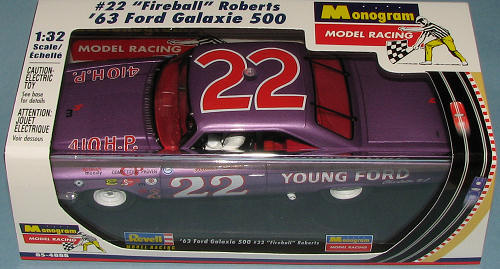
Monogram 1/32 1963 Ford Galaxie
| KIT: | Monogram 1/32 1963 Ford Galaxie |
| KIT #: | 85-4888 |
| PRICE: | $44.00 MSRP ($33.70 at www.greatmodels.com) |
| MARKINGS: | #22 Fireball Roberts car |
| REVIEWER: | Scott Van Aken |
| NOTES: |

| HISTORY |
Perhaps the greatest driver never to win a NASCAR title, Roberts accumulated 33 wins, including the 1962 Daytona 500, in a career that spanned 16 seasons before his untimely death in 1964 from injuries incurred in a fiery accident at Charlotte Motor Speedway. Roberts finished second to Bill Rexford in his rookie season. He split his time between the NASCAR Grand Nationals and the NASCAR Modifieds for five years before returning full-time to NASCAR Grand National racing. In his first year back, 1956, Roberts won 5 races and 4 pole positions to finish 6th in the point standings. He raced only 10 times in 1958 but had six wins, one second and a third, and finished 11th in the point standings despite missing almost 80% of the races!
Born
January 20, 1929 in Daytona Beach and raised in Apopka, Florida, Edward Glenn
Roberts Jr. attended the University of Florida but never graduated. He preferred
racing and struck out to find his way into the sport. He found his way into
NASCAR late in 1949 and his career began in earnest. From an inauspicious start
on the hard-packed sands of Daytona Beach, Florida, he fashioned one of the most
successful and glamorous careers in NASCAR.
"Fireball" was a name everyone recognized. He was
the epitome of the exciting, young racing star. Oddly enough, he didn't get the
nickname through his on-track achievements. Rather, he earned it for his ability
to throw a baseball from his years as a pitcher in youth baseball in
Apopka. Thank goodness for the racing world, baseball was never his primary
interest. Racing was.
From the time
he started on the Daytona beach course when he was 19, where he wrecked on the
ninth lap of a Modified race, until his untimely death in 1964, Roberts shaped a
career that saw him with 35 poles and win 33 times and 22 runner-up positions
in 206 races. He set an astonishing 400 records at various tracks, leading a
total of 5,970 laps including 1,644 laps led at tough, old Darlington
Raceway, SC, NASCARS's first super speedway.
He won several times over the years, but it was on the fast, exciting new super speedways that began to crop up in the late '50s and early '60s that he made his mark. Darlington was his favorite super speedway and on it, Roberts became one of NASCAR's best in the fledgling start of the big track era. He won the Rebel 300 in 1957 and 1959 and the Southern 500 in 1958 and 1963. In 1960, he won the Dixie 500 at Atlanta International Raceway. His 1962 Daytona 500 and July Firecracker 400 victories made him the first to sweep the speedway's two events in a single season.
His 1963 victory at Charlotte Motor Speedway was particularly significant. He came to the track in excellent physical shape after recovering from an injury. His plan was to start in the middle of the pack, which meant having to qualify on the second day. During practice however, he hit the guardrail in his No. 22 Holman-Moody Ford and almost washed the car out. But it was repaired in time for him to set a qualifying mark of 133.819 mph that got him the ninth starting spot. Roberts was known as a predictable hard-charger, but he ran a uncharacteristically cautious race until the latter stages, when he then began to charge. He took the lead with only 75 laps left and won in a cakewalk. He had run the perfect race, saving man and machine.
A year later at Charlotte Motor Speedway, Roberts was involved in a fiery crash with Ned Jarrett and Junior Johnson. Severely burned, he survived for 37 days before he succumbed to pneumonia.
| THE CAR |
This is a new slot car from Revell using the Monogram label to
promote its series of early/mid 1960s NASCAR racers. Though Revell is a stronger
name in Europe, in the US, it was Monogram that many of us baby boomers t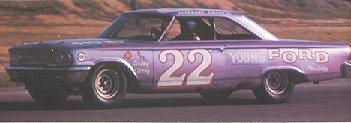 urned
to when we bought our first slot car set. It really is just marketing as all of
the various cars by both Revell and Mongram are built in a factory in Shanghai.
urned
to when we bought our first slot car set. It really is just marketing as all of
the various cars by both Revell and Mongram are built in a factory in Shanghai.
Packaged in what is pretty much an industry standard, it comes in a
plastic case, with the car itself held down by a central screw. A section of
plastic is between the base and the bottom of the car to hold the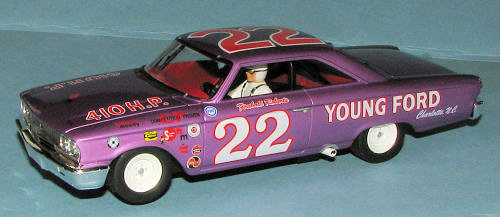 car slightly up off the base itself. This is to prevent flat-spotting the rubber
tires that come stock.
car slightly up off the base itself. This is to prevent flat-spotting the rubber
tires that come stock.
The painting and markings on the car itself are very well done and come close to matching the real thing. I have a photo of this car and while there were often differences in markings from race to race, it is pretty darn close to the photo. As it is with aircraft markings, it is a bit silly to be too pedantic about markings because they can be different from one race to another, especially if the car was damaged. These were the days before decals were used for numbers and the large sponsor markings on the cars and everything was hand painted. The chrome work is especially well done on this and other Revell cars. Scale model enthusiasts will probably be horrified to notice that there are no mold seams scraped and you can easily see where the parts were removed from the sprues as they are only given a cursory clean-up.
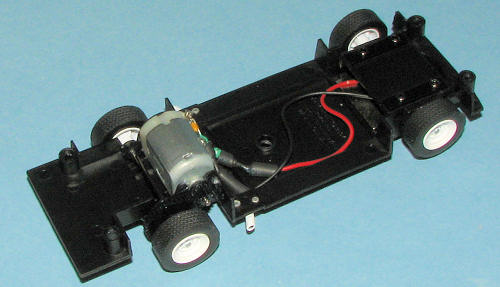 Anyway,
the chassis of this car is a bit different from other Revell cars. It is a
sidewinder just like many previous offerings, but in this case, in order to have
a full interior, the motor is placed up on its side. This provides the needed
room and also puts more weight to the rear of the car. A somewhat odd thing I
noticed is that there seems to be a resistor in line with the power leads that
go to the braid. It is almost as if Monogram thinks there motor is too powerful.
Anyway,
the chassis of this car is a bit different from other Revell cars. It is a
sidewinder just like many previous offerings, but in this case, in order to have
a full interior, the motor is placed up on its side. This provides the needed
room and also puts more weight to the rear of the car. A somewhat odd thing I
noticed is that there seems to be a resistor in line with the power leads that
go to the braid. It is almost as if Monogram thinks there motor is too powerful.
If wondering about the odd arrangement of the front axle assembly, this set-up allows fore and aft adjustment of the front axle. In this way, the chassis can be used on different cars of roughly the same wheelbase and used to center the front wheels.
A look at the underside of the chassis shows that, like on several
other Revell or Monogram cars, this one has two magnets. While the one in the
rear is generally considered enough, due
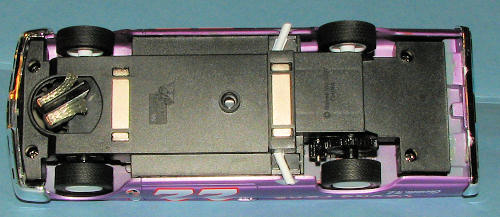 to the high
rear weight bias, I think that Monogram felt the forward magnet was a
requirement to keep the guide in the slot. I can tell you from running this car
that the front end does stay well planted. Thankfully, this has a more normal
guide with one set of braid, unlike their MRRC chassis cars that have a double
set. The rubber tires are soft enough to provide very good traction, especially
if one keeps the magnets. There are companies making silicone tires for this car
and on my 140 foot Scalextric Sport track, those silicones are good for about a
one second lap difference.
to the high
rear weight bias, I think that Monogram felt the forward magnet was a
requirement to keep the guide in the slot. I can tell you from running this car
that the front end does stay well planted. Thankfully, this has a more normal
guide with one set of braid, unlike their MRRC chassis cars that have a double
set. The rubber tires are soft enough to provide very good traction, especially
if one keeps the magnets. There are companies making silicone tires for this car
and on my 140 foot Scalextric Sport track, those silicones are good for about a
one second lap difference.
For those who are a bit new to the hobby, you might wonder how the
interior and other bits are held on. Well, it is a simple matter of using a low
temperature soldering iron to melt the pie ces
in place. If you look at this image of the underside of the body with the
chassis removed, you can see this. One thing it does do is make it easier to
remove these parts if one is going to repaint the car and use aftermarket
decals. Downside is that one has to glue the parts back in place so this
repainting is a one time deal. Glue also tends to come adrift more often if one
is a less than careful operator.
ces
in place. If you look at this image of the underside of the body with the
chassis removed, you can see this. One thing it does do is make it easier to
remove these parts if one is going to repaint the car and use aftermarket
decals. Downside is that one has to glue the parts back in place so this
repainting is a one time deal. Glue also tends to come adrift more often if one
is a less than careful operator.
As for the speed of the car, one has to realize that this is not only a large car, but it is also a taller one, making it a bit more top-heavy than say a LeMans prototype. Lap times on the aforementioned track with stock tires are in the low to mid 18 second range. The very fastest cars will dip into the 13s and sometimes the high 12s, though most other sports/GT cars are in the 15s. This makes the cars pretty quick. The gear ratio is such that dynamic brakes work fairly well. It is also a rather noisy car to operate. Some of this is due to the large, cavernous body and others to just needing to wear in the gears. Though the noise is still more than some, after several hundred laps, it does diminish somewhat.
| CONCLUSIONS |
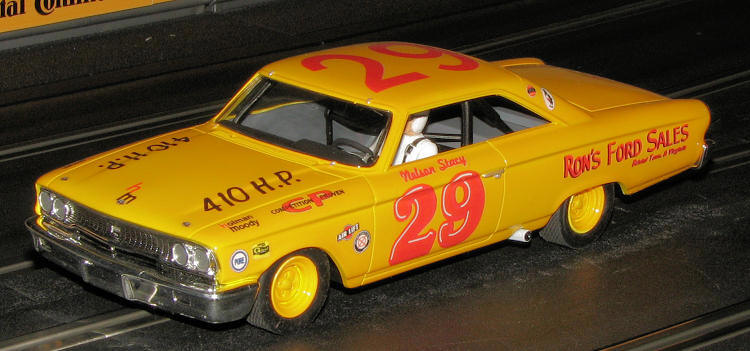 Overall this is an
excellent choice for Revell-Monogram. Having this 1963 Ford and the other 1965
Ford provides a number of other livery options that will allow a number of
different releases. Though licensing problems have cancelled the Junior Johnson
Ford, there are aftermarket sheets for a number of other interesting car types.
One that I recently did based on this car is this #29 Nelson Stacey car using
Darkside decals. In this case, I had to remove even more parts, strip and
repaint the red interior as well. Doing this allows many of us with static model
building experience to provide something different that we are pretty sure the
manufacturers will not provide.
Overall this is an
excellent choice for Revell-Monogram. Having this 1963 Ford and the other 1965
Ford provides a number of other livery options that will allow a number of
different releases. Though licensing problems have cancelled the Junior Johnson
Ford, there are aftermarket sheets for a number of other interesting car types.
One that I recently did based on this car is this #29 Nelson Stacey car using
Darkside decals. In this case, I had to remove even more parts, strip and
repaint the red interior as well. Doing this allows many of us with static model
building experience to provide something different that we are pretty sure the
manufacturers will not provide.
If you are into slot cars in general and 1/32 in particular, then you really should consider getting several of these. I can only hope that they will release some Chevrolets, Plymouths and perhaps even a Pontiac or two from this era.
| REFERENCES |
http://www.fireballroberts.com
June 2008 If you would like your product reviewed fairly and quickly by a
site that has over 300,000 visitors a month, please
contact
me or see other details in the
Note to
Contributors.